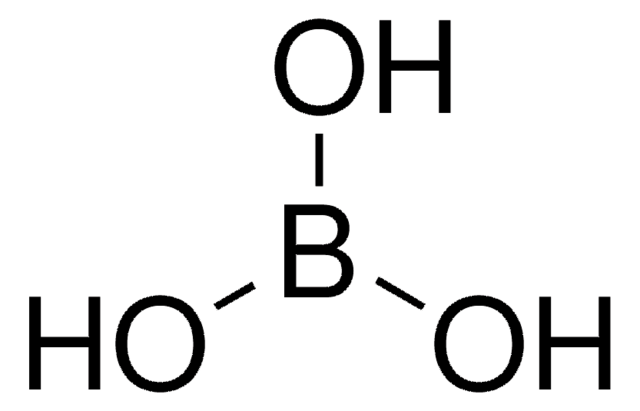31146
Boric acid
puriss. p.a., ACS reagent, reag. ISO, reag. Ph. Eur., buffer substance, ≥99.8%
About This Item
grade
ACS reagent
puriss. p.a.
Quality Level
agency
USP/NF
reag. ISO
reag. Ph. Eur.
vapor pressure
2.6 mmHg ( 20 °C)
assay
≥99.8%
form
powder or crystals
impurities
≤0.005% insoluble in methanol
≤0.05% with methanol-HCl non-volat. matter
pH
3.6-4.0 (20 °C, 4%)
mp
160 °C (dec.) (lit.)
solubility
water: soluble
density
1.440 g/cm3
anion traces
chloride (Cl-): ≤3 mg/kg
phosphate (PO43-): ≤5 mg/kg
sulfate (SO42-): ≤5 mg/kg
cation traces
As: ≤5 mg/kg
Ca: ≤10 mg/kg
Cd: ≤5 mg/kg
Cu: ≤5 mg/kg
Fe: ≤1 mg/kg
Mg: ≤5 mg/kg
Pb: ≤5 mg/kg
Zn: ≤5 mg/kg
SMILES string
OB(O)O
InChI
1S/BH3O3/c2-1(3)4/h2-4H
InChI key
KGBXLFKZBHKPEV-UHFFFAOYSA-N
Looking for similar products? Visit Product Comparison Guide
Related Categories
General description
Application
signalword
Danger
hcodes
Hazard Classifications
Repr. 1B
wgk_germany
WGK 1
flash_point_f
Not applicable
flash_point_c
Not applicable
Certificates of Analysis (COA)
Search for Certificates of Analysis (COA) by entering the products Lot/Batch Number. Lot and Batch Numbers can be found on a product’s label following the words ‘Lot’ or ‘Batch’.
Already Own This Product?
Find documentation for the products that you have recently purchased in the Document Library.
Customers Also Viewed
Our team of scientists has experience in all areas of research including Life Science, Material Science, Chemical Synthesis, Chromatography, Analytical and many others.
Contact Technical Service


